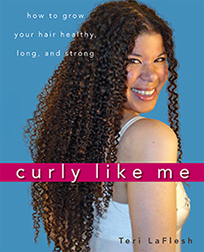
Available now!
Curly Like Me, the off-the-grid, do-it yourself owner's manual for tightly curly hair, is ready for ordering. Grab your copy today!

Every purchase made from
this site (through Amazon)
helps support it — and it
doesn't cost you anything
extra.
|
|
Here are some of the questions I get asked the most, and what my answers have been.
This way you can get your answers immediately, without having to wait on me.
And you never know, you might find answers to a few questions you didn't even know you had yet.
*This is still a work in progress. I'm continuing to add many more questions, and we are still ironing out a few quirks.
But we wanted to make this available as soon as possible.
There are several ways to choose the question(s) you'd like answered:
... or you can ...
... or you can ...
|
|
|
|
|
| |
Question:
What is "scab" hair?
Answer:
If you are experiencing a tight mat of hair at your scalp when you are trying to grow out very damaged hair, such as hair from a relaxer or any other chemical damage, you might have "scab" hair. (Flat irons can damage hair to the point it acts like it has a chemical on it. Flat irons don't mess around. In fact, one girl that I demonstrated how I would do my hair on the Growing It Out page had lost her curl due to flat irons alone).
This is because the relaxer works by totally changing the entire chemical structure that makes up your hair. It actually takes a double bond that puts your hair together, and breaks it apart so it's only a single bond that holds your hair together, making it much less flexible and weak. When this single bond chemically damaged hair meets up with the springy new growth with it's two bonds holding it together. This is often where the "scab" hair is formed, where these two radically different types of hair are joined it creates a mat.
Since these two textures are very different in how they behave, it's very easy to comb them differently. Generally, the chemical hair, since it's spirit has been broken (I know, my bias for natural hair is really showing), the comb goes through it easier than it does for the thicker, spirited new growth. And if you have scab hair, which is the mat that often forms where the two textures meet, you often have to tug pretty hard to get through that. The increased force needed can me enough to snap the fragile chemical hair, especially at the place where it's meeting the healthier new growth. This will often cause breakage.
I went through a phase of nearly a year where I got a huge mat in my hair where the damaged hair met the natural hair (not my natural hair's fault). Once more of my natural hair grew in, the mat moved down until my hair was long enough that I could cut it off. I've heard people refer to it as "scab" hair, and I think that's a great way of looking at it: like your hair was hurt with the chemicals, and now it's healing, and soon it is all better and happy, and then you'll start to see your curls coming in. So the "scab" is the area where the new growth and the damaged hair are attached to each other, and is not what your real hair will be like. Your real hair will follow the scab hair, just like brand new skin is beneath a scab where you were hurt.
What this means is that if your hair is doing what mine did while growing it out, you will have a band of hair that is kind of messed up. Then your real, true, natural curls will start growing in after this hair. It's very important to be very gentle with this new hair, because it's this hair that will grow long for you.
|
|
|